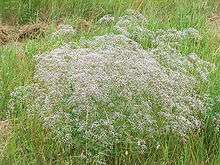Gypsophila paniculata
| Common Baby's-breath | |
|---|---|
 | |
| Gypsophila paniculata | |
| Scientific classification | |
| Kingdom: | Plantae |
| (unranked): | Angiosperms |
| (unranked): | Eudicots |
| (unranked): | Core eudicots |
| Order: | Caryophyllales |
| Family: | Caryophyllaceae |
| Genus: | Gypsophila |
| Species: | G. paniculata |
| Binomial name | |
| Gypsophila paniculata L. | |
_flowers.jpg)

Gypsophila paniculata (baby's breath, common gypsophila, panicled baby's-breath) is a species of flowering plant in the Caryophyllaceae family, native to central and eastern Europe. It is an herbaceous perennial growing to 1.2 m (4 ft) tall and wide, with mounds of branching stems covered in clouds of tiny white flowers in summer (hence the common name "baby's breath").[1] Its natural habitat is on the Steppes in dry, sandy and stony places, often on calcareous soils (gypsophila = "chalk-loving"). Specimens of this plant were first sent to Linnaeus from St Petersburg by the Swiss-Russian botanist Johann Amman.
Cultivation
It is a popular ornamental garden subject, and thrives in well-drained alkaline to neutral soils in full sun. Numerous cultivars have been selected, of which 'Bristol Fairy'[2] and 'Rosenschleier'[3] (with pale pink double flowers) have both gained the Royal Horticultural Society's Award of Garden Merit.
Floristry
G. paniculata is much used in the floristry trade (where it is often simply called "gyp") providing an effective backdrop for larger or more structured blooms. It is commercially cultivated in Peru, forming a major portion of that country's flower exports.[4]
Invasive
Gypsophila paniculata is now widely distributed in North America. [5] It is classed as an invasive species in places around the Great Lakes, such as the Sleeping Bear Dunes National Lakeshore [6] and the Chicago region, [7] and in the Pacific Northwest. [8]
References

- ↑ RHS A-Z encyclopedia of garden plants. United Kingdom: Dorling Kindersley. 2008. p. 1136. ISBN 1405332964.
- ↑ http://apps.rhs.org.uk/plantselector/plant?plantid=891
- ↑ http://apps.rhs.org.uk/plantselector/plant?plantid=893
- ↑ La floricultura en el Perú: La más alta calidad en Gypsphila
- ↑ PLANTS Profile - Gypsophila paniculata L. - baby's breath, PLANTS Database, U.S. Department of Agriculture. Retrieved 6 July 2010.
- ↑ Does removal of Baby’s Breath from Lake Michigan sand dunes restore native plant diversity and ecosystem function?, The Nature Conservancy. Retrieved 6 July 2010.
- ↑ Invasive Plants in the Chicago Region, Chicago Botanic Garden.
- ↑ Pacific Northwest Noxious Weed List, Pacific Northwest Invasive Plant Council. Retrieved 6 July 2010.
| Wikispecies has information related to: Gypsophila paniculata |
| Wikimedia Commons has media related to Gypsophila paniculata. |